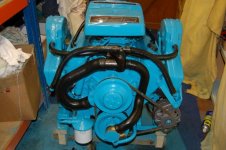mcw
Contributing Member
Hi all
Im in the process of getting me 430b v6 1992 engine all serviced up and ready for April, just about to do a complete filter change inc oil and im now unsure of what oil to use, the manual say SAE 20w/50 or 15w/50, but i have seen on the net they recommend 25w/40, also what are the differences between marine engine oil and normal auto oil, currently last year the boat was run with a good quality 20w/50 spec shell oil and the engine performed great not one drop burnt away and no top up needed at all.
So my question is what SAE spec of oil should i go for by todays standards in oil specification, the manual now is old so i would of thought the spec would change becuase oils are so much better than 15 years ago.
My second question is should i stick to auto oil or try and find marine engine oil in the spec i need, and would i notice a difference in the running if i use marine instead of auto oil.
mark
UK
Im in the process of getting me 430b v6 1992 engine all serviced up and ready for April, just about to do a complete filter change inc oil and im now unsure of what oil to use, the manual say SAE 20w/50 or 15w/50, but i have seen on the net they recommend 25w/40, also what are the differences between marine engine oil and normal auto oil, currently last year the boat was run with a good quality 20w/50 spec shell oil and the engine performed great not one drop burnt away and no top up needed at all.
So my question is what SAE spec of oil should i go for by todays standards in oil specification, the manual now is old so i would of thought the spec would change becuase oils are so much better than 15 years ago.
My second question is should i stick to auto oil or try and find marine engine oil in the spec i need, and would i notice a difference in the running if i use marine instead of auto oil.
mark
UK





